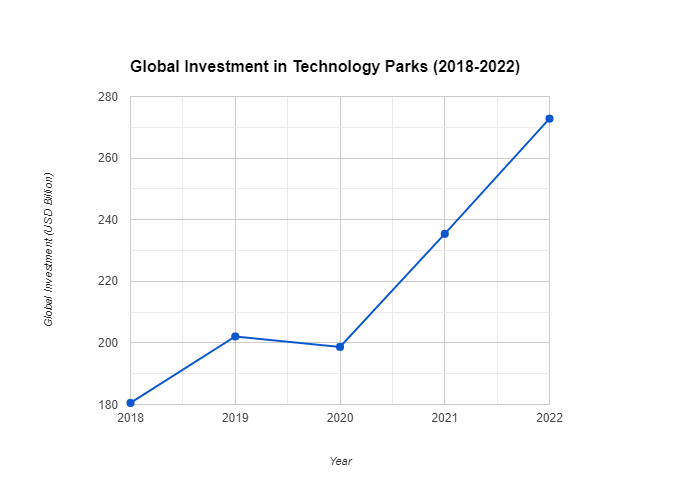Introduction
Technology parks are at the heart of innovation, driving technological advancements and economic growth. This blog explores the concept, objectives, and benefits of technology parks, with insights into global growth trends and significant examples.
What Are Technology Parks ?
Technology parks, often synonymous with innovation centers, science parks, or technopolis, are strategically designed areas that provide a supportive environment for the growth and development of tech-related businesses. They typically integrate office spaces, residential areas, and commercial facilities to create a conducive atmosphere for innovation and business operations. Managed by specialized professionals, these parks aim to foster a culture of innovation and enhance the competitiveness of associated businesses.

The Genesis of Technology Parks
The concept of technology parks dates back over 50 years to the establishment of the first technology park at Stanford University, which led to the creation of Silicon Valley. This area, once economically challenged, transformed into a global technology powerhouse, home to tech giants like Apple, Google, and Facebook. The success of Silicon Valley inspired the creation of similar clusters worldwide, recognized for their ability to drive economic growth and innovation.
Objectives of Technology Parks
Technology parks serve multiple objectives that collectively promote technological advancement and economic development:
- Advancement of Technology: These parks aim to advance scientific and technological endeavors by providing resources for research and development.
- Attraction of Investment: By offering a conducive environment for startups, technology parks attract significant investment, fostering economic growth.
- Company Establishment: They provide infrastructure and support for new and existing tech companies, facilitating their growth.
- Area Development: The concentration of tech companies in these parks leads to regional development, enhancing infrastructure and creating jobs.
- Employment Creation: The establishment of tech companies in these parks generates employment opportunities, benefiting the local economy.
Benefits of Technology Parks
Technology parks offer a plethora of benefits that extend beyond the immediate business environment:
- Boosting the Economy: Investments in technology parks can significantly boost regional and national economies. For example, Singapore’s one-north technology park has been pivotal in countering overseas competition.
- Space for Growth: These parks offer abundant space for business expansion, including office spaces, laboratories, and conference rooms. The University of Arizona Science and Technology Park, for instance, supports over 7,000 employees and contributes over $3 billion to the economy.
- Encouraging Business Development: Technology parks facilitate the growth of startups by providing essential infrastructure and support services.
- Training and Education: Parks like the University of Arizona’s offer extensive training opportunities, even housing educational institutions within their premises.
- Latest Technology and Amenities: Equipped with high-speed internet, telecommunication facilities, and other amenities, technology parks provide a modern and efficient working environment.
- Rest and Recreation: With green spaces, gyms, and recreational facilities, these parks promote employee well-being and work-life balance.
- Enhanced Security: Advanced security features protect sensitive data and assets, ensuring a safe working environment.
Global Growth Trends of Technology Parks
Global investments in technology parks continue to grow, indicating their significant role in innovation ecosystems. According to a McKinsey report, investments in tech trends, including technology parks, remained robust in 2022 with over $1 trillion combined, showcasing a high potential for future growth. Regions like Asia-Pacific and Europe have seen substantial growth in technology park developments, with increasing focus on sectors such as AI, quantum computing, and bioengineering.
Table: Growth Statistics of Technology Parks
| Region | Number of Tech Parks (2023) | Investment Growth (%) | Notable Examples |
|---|---|---|---|
| North America | 150 | 8 | Silicon Valley, Research Triangle |
| Europe | 120 | 7 | Sophia Antipolis, Cambridge Science Park |
| Asia-Pacific | 200 | 10 | one-north, Zhongguancun |
| Middle East | 50 | 5 | Dubai Silicon Oasis |
The growth statistics highlight the increasing investments and the establishment of technology parks across various regions, reflecting their critical role in driving technological advancements and economic growth.
Figure: Global Investment in Technology Parks (2018-2022)

The figure illustrates the steady increase in global investments in technology parks over the past few years, emphasizing their importance in the innovation landscape.
Case Study: Software Technology Parks of India (STPI)
India’s STPI, established in 1991, has been instrumental in positioning the country as an IT superpower. With centers across major cities, STPI provides infrastructure, statutory support, and services to promote software exports. The organization also focuses on entrepreneurship through incubation programs and works closely with state governments to foster IT growth. STPI’s model has significantly contributed to the growth of India’s IT sector, making it a notable example of the impact technology parks can have on national development.
Future Prospects and Challenges
As technology continues to evolve, technology parks must adapt to emerging trends and challenges. The integration of next-generation technologies such as artificial intelligence, quantum computing, and biotechnology will be crucial. These parks must also address challenges such as talent acquisition, cybersecurity, and sustainable development.
1. Integration of Emerging Technologies: The future of technology parks lies in their ability to integrate emerging technologies. For instance, the adoption of AI and machine learning can enhance operational efficiencies and drive innovation. The promise of quantum computing, despite being in its early stages, is immense. Quantum computing can potentially revolutionize various industries by solving complex problems much faster than traditional computers, opening new avenues for research and development. Biotechnology advancements can lead to breakthroughs in healthcare, agriculture, and environmental sustainability.
2. Talent Acquisition and Retention: One of the significant challenges for technology parks is the acquisition and retention of skilled talent. The demand for professionals with expertise in advanced technologies often surpasses the supply, leading to a talent crunch. Technology parks must invest in educational and training programs to develop a skilled workforce. Partnerships with universities and research institutions can help bridge the talent gap by providing continuous learning opportunities.
3. Cybersecurity: As technology parks become hubs of innovation, they also become targets for cyber threats. Ensuring robust cybersecurity measures is crucial to protect sensitive data and intellectual property. Parks must implement advanced security protocols and stay updated with the latest cybersecurity trends to mitigate risks.
4. Sustainable Development: Sustainability is a growing concern for technology parks. Implementing green technologies and sustainable practices can reduce the environmental impact of these parks. Initiatives such as energy-efficient buildings, waste management systems, and renewable energy sources can contribute to sustainable development.
5. Collaboration and Ecosystem Building: The success of technology parks depends on their ability to build strong ecosystems through collaboration. Partnerships with industries, academic institutions, government bodies, and other stakeholders can drive innovation and economic growth. Collaborative efforts can lead to the sharing of resources, knowledge, and expertise, fostering a culture of innovation.
Conclusion
Technology parks are vital for fostering innovation, economic development, and technological advancement. By offering a blend of business, residential, and recreational facilities, these parks create unique ecosystems where companies and communities can thrive. As demand for technology and innovation rises, the role of technology parks will become increasingly significant. Investing in these parks is investing in the future of technology and economic growth. The success stories of Silicon Valley, one-north, and STPI highlight the transformative power of technology parks, making them indispensable assets in the global innovation landscape.
